I. What are Linked Genes in Mendelian Genetics?
Congratulations! If you’re here, you’ve probably already covered and reviewed the other topics of our study articles concerning the wide fundamentals of Mendelian genetics. From punnett squares to Mendel’s laws, you’ve covered the whole 9 yards, awesome job!
Unfortunately, as with other laws and principles, there are some that too have exceptions; likewise, Mendel’s laws too have exceptions that can sometimes cause confusions and contradictions to what you’ve previously learned and studied before!
As stated in the title, one exception to Mendel’s law is gene linkage, specifically an exception to the law of independent assortment. This can definitely be one of the more confusing topics, but we’ll do our best to break it down in an easier, more concise way!
II. Content Review
Before getting down to understanding what linked genes are, let’s first expand and get a more in depth dive into chromosomal structure.
Recall that many genes can be housed in a single chromosome; fortunately there are terms that are used in order to describe the distance between these genes.
In genetics, the term centimorgans or map units (mu) are used as a sort of metric to describe the distance between genes on chromosomes. For example, genes A and B can be 18 centimorgans apart while genes B and C can be 6 centimorgans apart.
Usually, the MCAT will test your knowledge on gene map units via gene mapping, which describe the process of finding the order of genes on a chromosome. Take the example below of gene mapping given the following map unit values.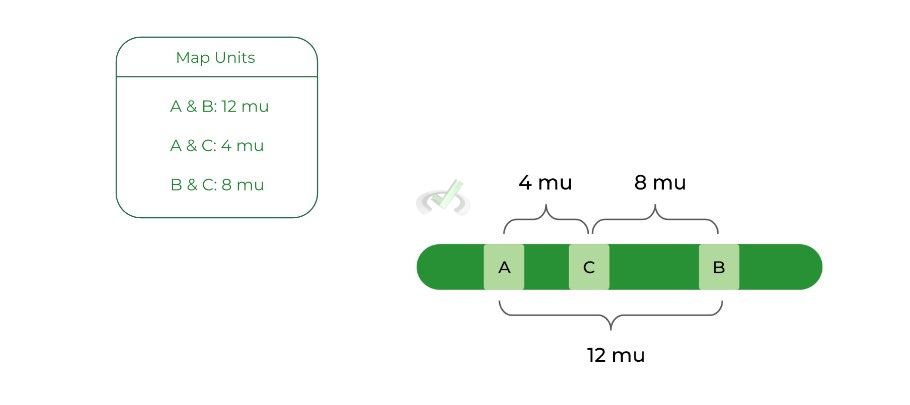
Because genes A & C are separated by 4 map units (the smallest), they are the genes that are closest together; vice versa, genes A & B are the farthest from one another, separated by 12 map units.
Since genes A and B have the largest map unit distance separation, then the sum of the map unit distance between A & C and C & B should equal the distance separation between genes A & B.
In addition, think of this more as a “lineup” instead of “order”. It’s misconstruing to think of it as: “A first, C second, and B third” because you can also read from the other chromosome end.
How do all these gene metrics and distance become a problem and exception for Mendel’s law of independent assortment? As it so happens, the closer 2 genes are one the same chromosome, the more likely they are to be placed on the same gamete.
⇒ Breaks Mendel’s law of independent assortment, which states that the allele received for one gene by a gamete DOES NOT affect the allele received for another gene!
Why is this so? Let’s take a look at the bridge/overlap section to see how all these variables come into play.
III. Bridge/Overlap
Recall that in prophase I of meiosis that a process called crossing over occurs, which is essentially a form of genetic recombination.
Here, the 2 NONSISTER CHROMATIDS of the homologous chromosomes will swap genetic segments which aids in the development of genetic variation!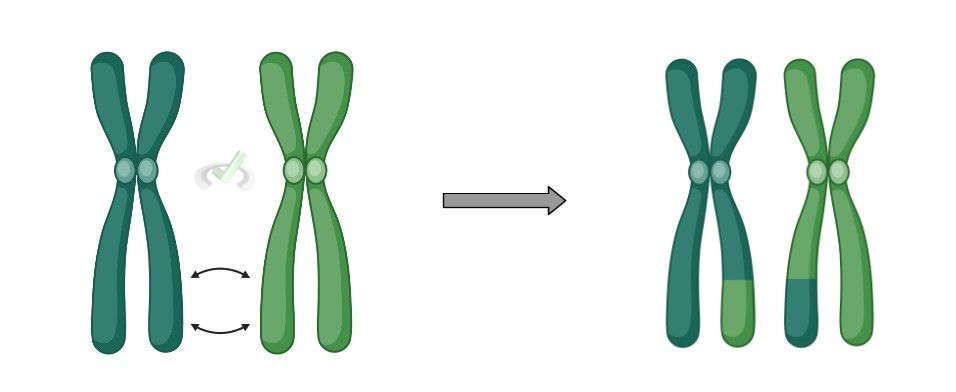
However, as mentioned above, this poses a problem to the law of independent assortment when genes on the same chromosome are close. Let’s look at 2 different cases for crossing over: one where the genes are close in proximity and one where the genes are far apart.
⇒ Case 1: Genes Close
If the genes are close in proximity to one another, there is a HIGH probability that they will crossover together! Another way to view it is that the genes are most likely not going to be separated during the crossing over event.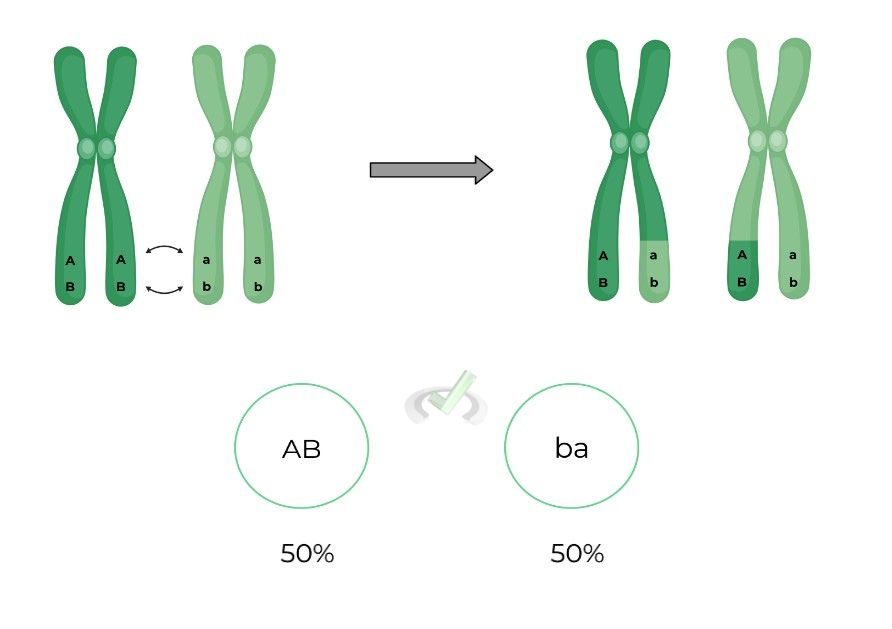
As shown, the resulting gametes once meiosis is complete will only be “AB” and “ba”. According to Mendel’s law of independent assortment, there should also be the production of “Ba” and “Ab” gametes!
Linked genes (genes close to one another) are an exception to this rule. Because the genes are less likely to separate from each other during crossing over, it reduces the genetic variability. Think of these genes like they’re “packed” together!
⇒ Case 2: Genes Far Apart
If the genes have a far distance to one another, there is a LOW probability that they will crossover together! Another way to view it is that the genes are most likely going to be separated during the crossing over event.
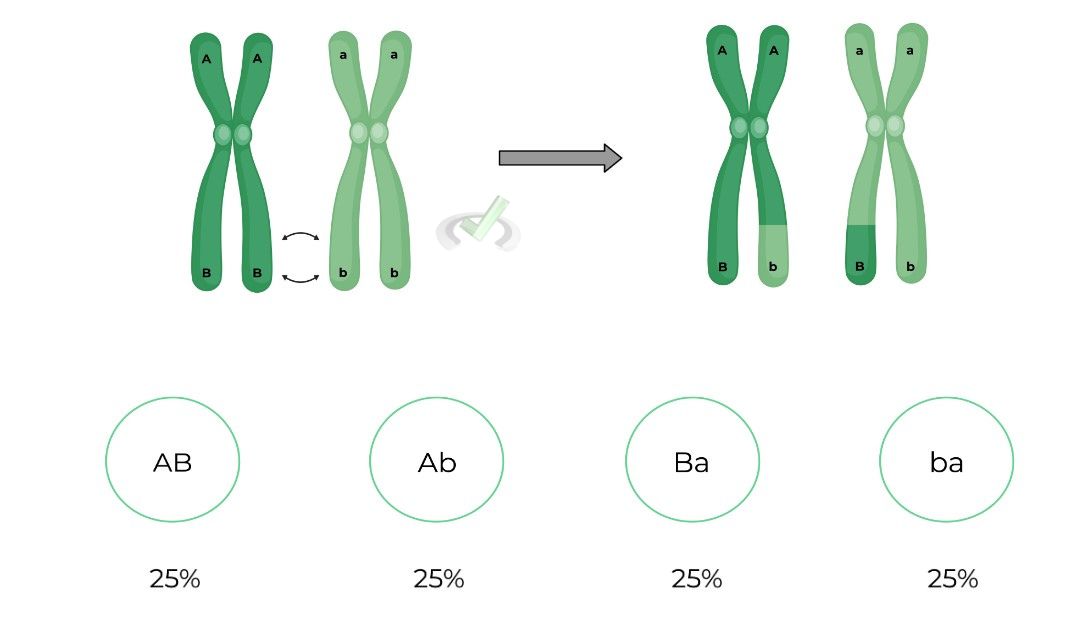
Now, we’re shown the more familiar gamete distribution that should follow Mendel’s law of independent assortment. Because the genes are farther apart they will most likely be separated during crossing over, increasing the genetic diversity that can be generated.
As a simple rule of thumb, genes that are close together will most likely NOT FOLLOW independent assortment while genes that are farther apart will most likely FOLLOW independent assortment.
Are there instances where genes always follow independent assortment? Yes! This is the case for when genes are located on SEPARATE chromosomes. This makes sense
because the genes are never linked & thus will alway follow independent assortment.
>> Recombination Frequency
From the gene distances and crossing over comes a similarly related term of recombination frequency (𝜃), which basically describes the probability that 2 genes will be separated during crossover.
As it so happens, the recombination frequency is EQUAL to the centimorgan/map unit distance between the 2 genes. This should make sense because the closer the genes are, the less likely they are to be separated (i.e. a low recombination frequency).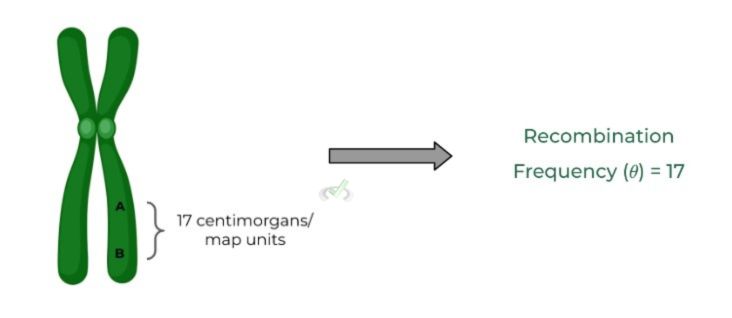
It’s also of note and useful to memorize that the value for recombination frequency CANNOT exceed 50, which occurs when genes are at opposite ends of the chromosome.
Though understanding why the value does not exceed 50 is beyond the scope of the MCAT, definitely look up online resources and references which explain this!
IV. Wrap Up/Key Terms
Let’s take this time to wrap up & concisely summarize what we covered above in the article!
In order to describe the distance between genes on the chromosomes, we can use the terms centimorgans/map units as a metric!
The centimorgan/map unit value between 2 genes is actually also equal to the 2 genes recombination frequency (𝜃), the probability that the genes will be separated during crossing over.
Linked genes refer to genes on the same chromosome that are located in close proximity to one another. As such, they are more likely to be “paired together” during crossing over and be together in the same gamete, violating Mendel’s law of independent assortment.
As a good rule of thumb, genes which are close to each other in proximity will likely NOT FOLLOW independent assortment while genes far apart from each other will likely FOLLOW independent assortment!
V. Practice
Take a look at these practice questions to see and solidify your understanding!
Sample Practice Question 1:
Given the following recombination frequencies between the gene pairs, what is the correct order of the genes on the chromosome?
A & B: 8B & D: 3
A & C: 13B & C: 5
A & D: 11C & D: 2
A. ABCD
B. BDCA
C. CBAD
D. ABDC
Ans. D
While it might at first look difficult, we’ll show a real trick on this question to limit down your answer choices! The first step that you should do is to identify which genes are furthest apart (i.e. those with the highest recombination frequency).
From there, take the 2 ends and work inward: in this case, genes A & D will be at the end. The closest gene to gene A should be gene B because it has the lower recombination frequency between A & B and A & D.
Likewise, the closest gene to gene D should be gene C because it has the lower recombination frequency between A &D, B & D, and C & D.

Sample Practice Question 2:
Genes A and B are 7 centimorgans apart, genes A and C are 12 centimorgans apart, and genes B and C are 5 centimorgans apart. Given this, which gene pair is most likely to NOT follow the law of independent assortment?
A. A & B
B. B & C
C. A & C
D. Cannot determine.
Ans. B
Remember that linked genes (genes that are close together in proximity will most likely NOT FOLLOW independent assortment; this is because that the gene have a higher probability of crossing over together and being in the same gamete, violating Mendel’s law of independent assortment.




 To help you achieve your goal MCAT score, we take turns hosting these
To help you achieve your goal MCAT score, we take turns hosting these 
























